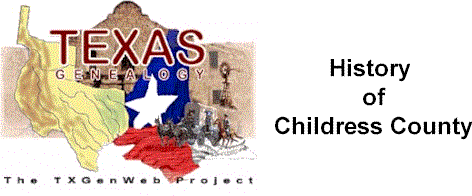|
Childress
County
was created in 1876 and was organized in 1887. The city ofChildress and Childress County
were named in honor of George Campbell Childress, author of the
Texas Declaration of Independence.
Childress County, located
in the southeast corner of the TexasPanhandle
was, in the early 1870s, occupied almost entirely by four ranches:The
Mill Iron,Diamond
Tail,Shoe
Nail, andOX.
Unorganized and attached to Donley County for judicial purposes,
there were enough settlers to organize by 1887. There were two
communities vying for county seat: Henry and Childress, which
was located three miles from the present site. Ultimately Henry
was renamed Childress and the three existing businesses in old
Childress relocated in the new county seat.
A fire destroyed the courthouse on October 21, 1891, which contained
all of the records in the office of the county clerk. Records
were re-recorded as land owners submitted their original deeds
or secured substitute deeds, though a great number of them were
never submitted. Fortunately an abstract plant was in business
before the courthouse fire, and records were still available.
The OX Ranch covered 30 square miles or about 19,200 acres which
included the present county seat and was owned by A. Forsythe
of Missouri and D.D. Swearingen of Ohio who formed the Forsythe
Land and Cattle Company. They obtained most of the land from
the State of Texas for fifty cents per acre for certification.
Following the death of Forsythe in 1899, ownership changed to
White and Swearingen.
To prevent farmers from penetrating into the county, Forsythe
paid a good price for the land occupied by the farmers and the
crops and implements owned by them in order to keep them off
the range. His successors, in part, followed the same policy,
and for the next 45 years the range belonged to the cattle while
farmers had a disheartening time.
In 1883 the OX-operated land was termed "Lariat Land".
It was the custom of the ranches to file and gain title for certain
sections of the land, but they would only pay a portion of the
patent fee, thus insuring themselves against any person occupying
the land. This explains why many settlers filed on land near
the vicinity of Childress that was called OX Ranch Territory,
but legally was not.
Before the Fort Worth and Denver City Railroad Company extended
rails through the county the OX cattle were driven to market
over the Palo Duro-Dodge City trail to Dodge City, Kansas. Most
of the herds contained from 1,000 to 1,500 head as they left
for market. Trail drives had almost ended by 1885. Settlers began
moving into the area, filing on the land under the land laws
of the state, and by obtaining a legal title for the land, did
away with the grazing rights established by the OX Ranch.
A special act of the Texas Legislature in 1873 granted charter
to the Fort Worth and Denver City Railway which gave the power
to construct a line from "some suitable point at or near
Fort Worth forming a junction at said point with the Texas and
Pacific Railway: Thence in a northwesterly direction, on the
most practicable route through the State of Texas, in the direction
of Denver City, Colorado, having in view the route best calculated
to develop in the mineral region of Northwestern Texas".
The mineral region referred to contained coal fields which were
located in some of the vicinities through which the road was
projected.
A railroad line through the community always gave new life and
hope to the citizens. For decades the railroad shops in Childress
were some of the largest employers and some, whose hard work
built the community, were men of the rails.
Contributed by; Clemi
Blackburn from information found in: "The Childress County
Story" by Michael G. Ehrle
Baccalaureate Program from Childress High 1956
1st
Killing in Childress Co.
|

